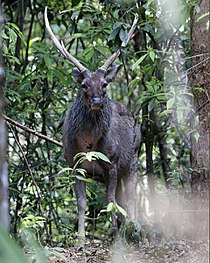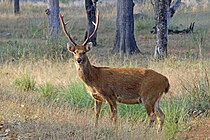Cervids are one of the most common wild herbivores of the world. Of these moose can grow up to 2.33 m tall and weigh as much as 820 kg. The smallest of them all is the northern pudu.
| Rank | Cervid | Binomial name | Known maximum mass [kg (lbs)] |
Shoulder Height [m] |
Image |
|---|---|---|---|---|---|
| 1 | Moose | Alces alces | 820 (1808) [1] | 2.33 | 
|
| 2 | Elk | Cervus canadensis | 600 (1323)[2] | 1.6 | 
|
| 3 | Sambar | Rusa unicolor | 546 (1204)[3] | 1.6 | 
|
| 4 | Red deer | Cervus elaphus | 500 (1102)[4] | 1.4 | 
|
| 5 | Reindeer | Rangifer tarandus | 318 (701) [5] | 1.5 | 
|
| 6 | Barasingha | Rucervus duvaucelii | 280 (617) [6] | 1.3 | 
|
| 7 | White-tailed deer | Odocoileus virginianus | 232 (512) [7] | 1.2 | 
|
| 8 | Thorold's deer | Cervus albirostris | 230 (507) [8] | 1.4 | 
|
| 9 | Mule deer | Odocoileus hemionus | 210 (463) [9] | 1.2 | 
|
| 10 | Père David's deer | Elaphurus davidianus | 200 (441) [10] | 1.2 | 
|
- ^ Wood, The Guinness Book of Animal Facts and Feats. Sterling Pub Co Inc. (1983), ISBN 978-0-85112-235-9
- ^ Eide, Sterling. "Roosevelt Elk". Alaska Department of Fish and Game. Retrieved 2010-12-04.
- ^ 1.Burnie D and Wilson DE (Eds.), Animal: The Definitive Visual Guide to the World's Wildlife. DK Adult (2005), ISBN 0789477645 2."Comparative Placentation". Placentation.ucsd.edu. Retrieved 17 August 2012.
- ^ Geist, Valerius (1998). Deer of the world: their evolution, behaviour, and ecology. Stackpole Books. p. 202. ISBN 0-8117-0496-3.
- ^ Caribou at the Alaska Department of Fish & Game Archived 30 December 2013 at the Wayback Machine.. Adfg.state.ak.us. Retrieved on 16 September 2011.
- ^ Schaller, G. B. (1967). The Deer and the Tiger – A Study of Wildlife in India. University Chicago Press, Chicago, IL, USA.
- ^ "The Outdoor Life Book of World Records". Outdoor Life. Retrieved February 20, 2011.
- ^ Leslie, D.M. (2010). "Przewalskium albirostre (Artiodactyla: Cervidae)". Mammalian Species. 42 (1): 7–18. doi:10.1644/849.1.
- ^ Petersen, David (Nov./Dec., 1985). "North American Deer: Mule, Whitetail and Coastal Blacktail Deer". Mother Earth News. Ogden Publications, Inc. Retrieved 4 January 2012. Odocoileus hemionus, Animal Diversity David Burnie (1 September 2011). Animal: The Definitive Visual Guide to the World's Wildlife. Dorling Kindersley Limited. ISBN 978-1-4053-6233-7. "Deer (Family Cervidae)". Retrieved 8 January 2014.
- ^ "Père David's Deer (Elaphurus davidianus)". Deer. Gland, Switzerland: World Association of Zoos and Aquariums. 2012. Retrieved 2012-05-20.